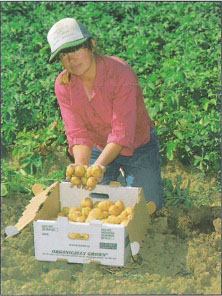All Issues
Women, minority farmers are growing in California
Publication Information
California Agriculture 54(1):8-9.
Published January 01, 2000
PDF | Citation | Permissions
Summary
Women, minority farmers Grandparents become parents Tidal Wave It
Full text
As California agriculture and population become increasingly diverse ( see p. 11 ), women and ethnic minorities are finding new opportunities to own and operate farms.
“In the long term, it's inevitable that we'll see greater diversity” among growers, says Desmond Jolly, director of the UC Small Farm Center. “The trend is clear and irreversible.”
According to the U.S. Census of Agriculture, 14% of California farm operators in 1997 were female (10,064), up from 11% of the total a decade earlier. During the same time-period, farm operators of Spanish, Hispanic or Latino origin increased 30%, from 3,471 in 1987 to 4,515 in 1997, while the number of Asian, black, American Indian and “other” owners increased 21%, from 3,663 in 1987 to 4,430 in 1997.
Steven Blank, farm finance management specialist at UC Davis and author of The End of Agriculture in the American Portfolio, says California's total acreage and the number of distinct farming operations slowly continue to shrink, yet the relative percentage of small farms is growing. Many new farm operators are women and immigrants, who generally start new businesses on smaller farms.
“The smaller size of farms allows easier entry in comparison with other businesses,” Jolly says.
Nonwhite growers.
New immigrants to California during the past two decades (such as Southeast Asian refugees) often feel at home on small farms in the Central Valley, Blank says, while long-term immigrants (such as workers from Mexico) have “acquired wealth and are now able to own farms” ( see p. 33 ).
“Many new immigrants are not coming from an urban setting,” Jolly agrees. “It's easier to adjust to rural heritage and culture.” Farm operation and ownership allows Hispanic immigrants greater stability than working in the fields, although it is still a “risky and marginal enterprise,” he says.
Despite the historical dominance of Europeans in California agriculture, black farmers built a number of Central Valley towns, while Sikh growers and other ethnic groups have a “long and distinguished history of agriculture in the state,” says Al Medvitz, UC Davis lecturer and Solano County grower.
Women growers.
The increase in female farmers has also occurred primarily on small farms, Blank says, either with wives taking over when their husbands die or obtain off-farm jobs, or with women starting their own specialty or “niche” operations.
Specialty farming often appeals to women because “they can go anywhere in the state and grow something,” says Jeri Hansen, vice president of California Women in Agriculture (CWA), a trade association with 3,500 members and 27 chapters.
Janet Pauli, operator of Pauli Ranch, oversees crews of between 25 and 80 workers on 450 acres of wine grapes and 60 acres of pears in Mendocino County. “I may get more respect [from mostly male crews] automatically because of being female,” Pauli says.
Farming has also allowed Pauli to seamlessly integrate her work and family lives. “It's wonderful to work here and be with my children,” says Pauli, who has two sons with husband Bill, president of the California Farm Bureau Federation. “The children are raised in it. Day care has never been a problem. Some women find it much easier to raise kids on the farm.”





